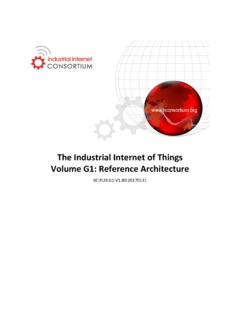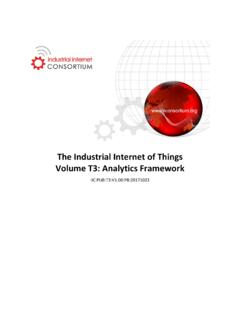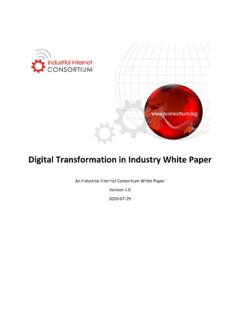Transcription of Introduction to Edge Computing in IIoT
1 Introduction to Edge Computing in IIoT An Industrial Internet Consortium White Paper IIC:WHT:IN24 :PB:20180618 Edge Computing Task Group Introduction to Edge Computing in IIoT IIC:WHT:IN24 :PB:20180618 - 2 - Almost every use case and every connected device focused on by the Industrial Internet Consortium (IIC) requires some sort of compute capability at its source, at the edge. Multiple sources define edge Computing as cloud Computing systems that perform data processing at the edge of the network, near the source of the data . While this is certainly true, it only scratches the surface of the immense power and remarkable capabilities that edge Computing applications and architectures can provide to solve industrial internet users toughest challenges. But, as is typical with any powerful technology, innovative architectures and new terminology are needed to facilitate implementation, bringing increased complexity with it.
2 Purpose and Audience This white paper provides practical guidance on edge Computing , architectures and the building blocks necessary for an edge Computing implementation. It defines edge Computing architectural functions and highlights key use case considerations Consequently, there is a need to identify: where the edge is, its defining characteristics, key drivers for implementing edge Computing and why compute capabilities should be deployed at the edge in Industrial Internet of Things (IIoT) systems. It also informs architecture and testbed teams through: identifying and evaluating standards, practices and characteristics best suited for addressing edge Computing holistically, and highlighting gaps where needed, identifying deployment models and crosscutting functions that address patterns and characteristics for edge Computing deployment and exploring and identifying extensions to the current edge Computing model that expand and enhance the functionality of edge Computing devices.
3 Several detailed use cases are highlighted, edge Computing for industrial analytics is explored and security challenges for edge Computing implementations are also considered. (Detailed security information from the IIC can be found in the Industrial Internet Security ) 1 The Industrial Internet of Things; Volume G4: Security Framework, Industrial Internet Consortium (IIC), 2016: Introduction to Edge Computing in IIoT IIC:WHT:IN24 :PB:20180618 - 3 - Viewpoints and Crosscutting Concerns This whitepaper targets the technical community and focuses on the functional and implementation viewpoints from the IIC s Industrial Internet Reference Architecture2 (IIRA): The functional viewpoint focuses on the functional components in an IIoT system, their structure and interrelation, the interfaces and interactions between them and the relation and interactions of the system with external elements in the environment to support the usages and activities of the overall system.
4 These concerns are of interest to system and component architects, developers and integrators (see IIRA Chapter 6). The implementation viewpoint deals with the technologies needed to implement functional components (functional viewpoint), their communication schemes and their lifecycle procedures. These elements are coordinated by activities (usage viewpoint) and supportive of the system capabilities (business viewpoint). These concerns are of interest to system and component architects, developers and integrators and system operators (see IIRA Chapter 7). It identifies the attributes of edge Computing related to the Edge, Platform and Enterprise Tiers described in the IIRA as well as the crosscutting functionality such as data management, connectivity, orchestration, analytics and security.
5 This white paper has a technical focus to identify deployment models and edge- Computing implementation patterns across the several crosscutting functions. Figure 1 shows a multi-layer edge Computing architecture with crosscutting functions useful in deploying edge- Computing architectures as defined by the IIRA. We fully recognize that the software driving edge Computing is an essential component of edge Computing implementations and architectures, but the sheer volume of operating system and platform choices options are beyond the scope of this white paper. 2 The Industrial Internet of Things; Volume G1: Reference Architecture Industrial Internet Consortium (IIC), 2018. Introduction to Edge Computing in IIoT IIC:WHT:IN24 :PB:20180618 - 4 - Figure 1: IIC Crosscutting Functions Across Edge Computing Architectures Where is the Edge?
6 The edge is a logical layer rather than a specific physical divide, so it is open to individual opinion and interpretation of where the edge is. The business and usage viewpoints provide clues, while the functional and implementation viewpoints deal with the technical aspects. From the business perspective, the location of the edge depends on the business problem or key objectives to be addressed. Quote Key objectives are quantifiable high-level technical and ultimately business outcomes expected of the resultant " and Fundamental capabilities refer to high-level specifications of the essential ability of the system to complete specific major business tasks . (Ref IIRA). There is a continuum of fundamental capabilities for an IIoT solution and the edge moves along this continuum based on the requirements of the problem at hand, as shown by the following examples found in typical industrial operations.
7 Introduction to Edge Computing in IIoT IIC:WHT:IN24 :PB:20180618 - 5 - Figure 2: Edge continuum for a typical industrial environment EXAMPLE 1: PROTECT EQUIPMENT FROM DAMAGE BY OVERHEATING In this scenario, a dumb thermocouple measures temperature on a pump. A pump with edge Computing capability can perform basic analytics to determine if a defined threshold is exceeded and shut the pump down in milliseconds. There is no decision latency and no need for connectivity to perform this function. Connectivity is not necessary, but it may be used for notification. The time value of the temperature information decays rapidly as delayed response can result in equipment damage. In this case the edge is at the device level as it can achieve the key objective, even if connectivity to higher-level systems and networks are interrupted.
8 EXAMPLE 2: MONITOR THE PERFORMANCE OF PLANT AREAS OR PRODUCTION LINES The performance of equipment and production lines are often expressed through performance indicators like Overall Equipment Effectiveness (OEE). Near real-time analytics on multiple data points from sensors in the plant area can be processed on a local gateway and provide OEE trends and alerts to operational systems or personnel. In this case, the fundamental capability requires information from multiple equipment sources to perform simple analytics. The time value of information is high as response delays waiting for decisions from the cloud can cause significant losses. This business problem suggests that the edge is at the plant area level. EXAMPLE 3: OPTIMIZE SUPPLY CHAIN FOR A LOCATION OR FACTORY TWICE DAILY optimizing supply chain processes for a local facility, factory or an oil field requires data from multiple sources at short intervals to apply optimization algorithms and analytics that will adapt supply-chain plans in business systems such as SCM or ERP.
9 The fundamental capability requires local or factory-level connectivity with decisions made in hours. Additional information outside the perimeter of the factory may be useful, but not mandatory for effective optimization. In this instance, the edge is at the perimeter of the factory, plant or local facility. Introduction to Edge Computing in IIoT IIC:WHT:IN24 :PB:20180618 - 6 - EXAMPLE 4: PREDICT EQUIPMENT FAILURE AND SCHEDULE PROACTIVE RESPONSE Machine learning models to predict Electric Submersible Pump (ESP) failures require data from multiple offshore platforms. The analytics models are complex and a large amount of data is needed to train and re-train the models. It also requires regular data feeds from operating ESPs to determine each unit s remaining useful life. The data from individual ESPs need to be analyzed regularly but information decay is much slower than in the other scenarios and decisions can be taken daily or weekly.
10 Computation is typically performed at the enterprise level using a public or private cloud and is at the top end of the edge continuum. The edge can be anywhere along the time-value graph (see Figure 3) as these examples illustrate. It is where data for sensors is used to achieve a specific key objective or address a specific business problem. Why Compute at the Edge Edge Computing is a decentralized Computing infrastructure in which Computing resources and application services can be distributed along the communication path from the data source to the cloud. That is, computational needs can be satisfied at the edge, where the data is collected, or where the user performs certain actions. The benefits are: improved performance, compliance, data privacy and data security concerns are satisfied and reduced operational cost.










